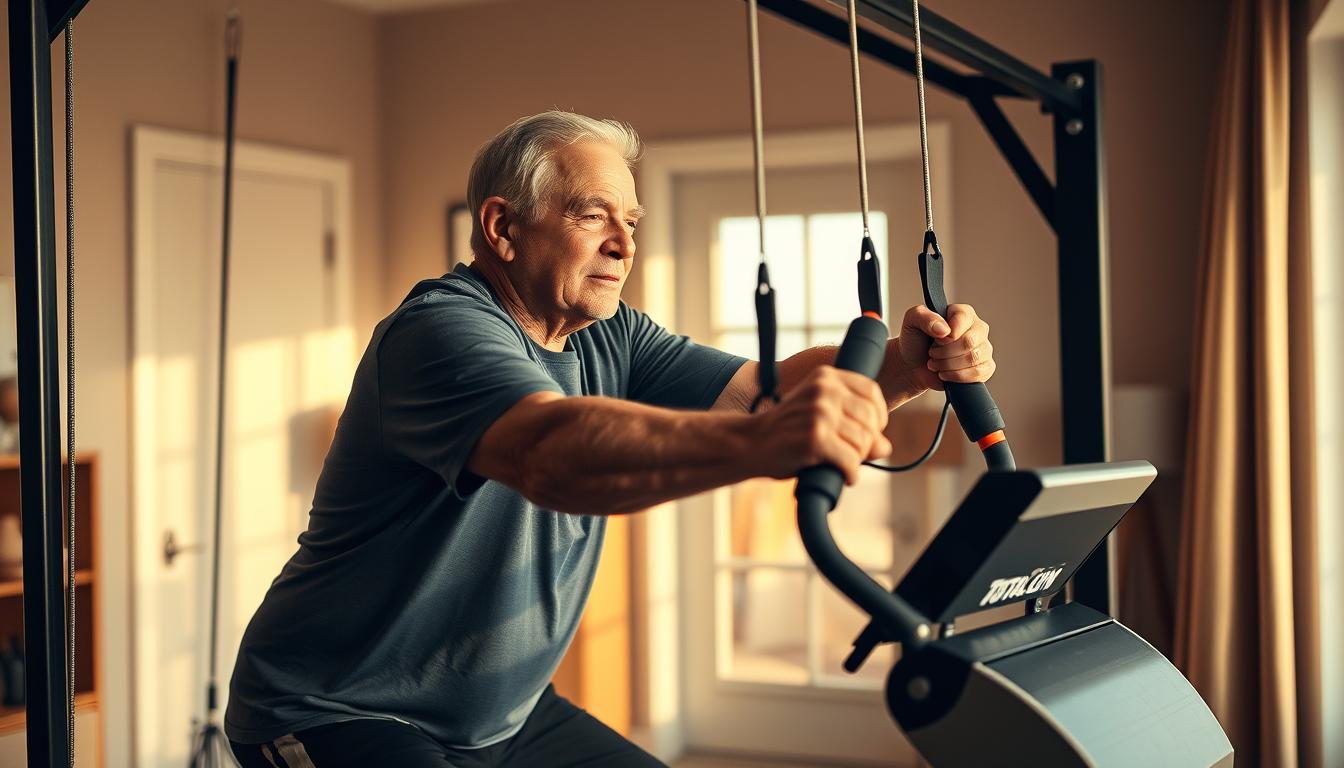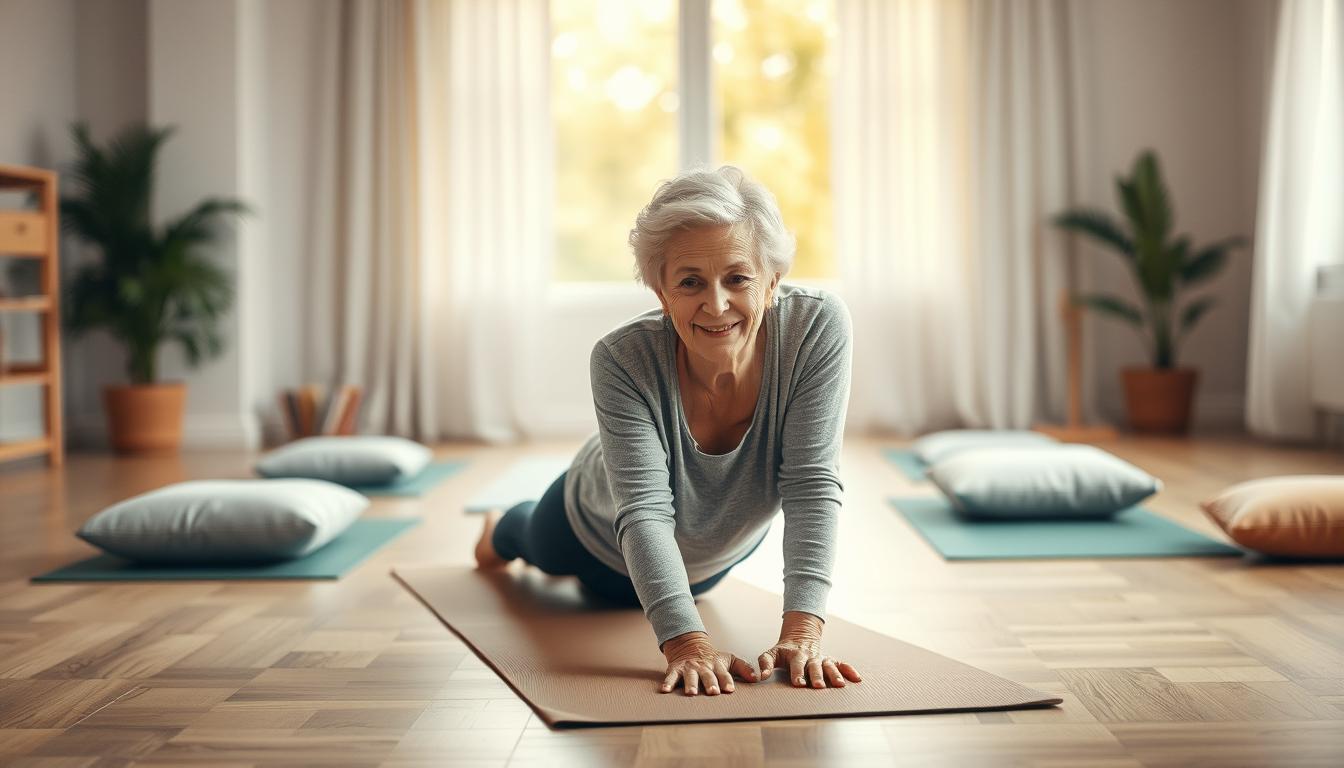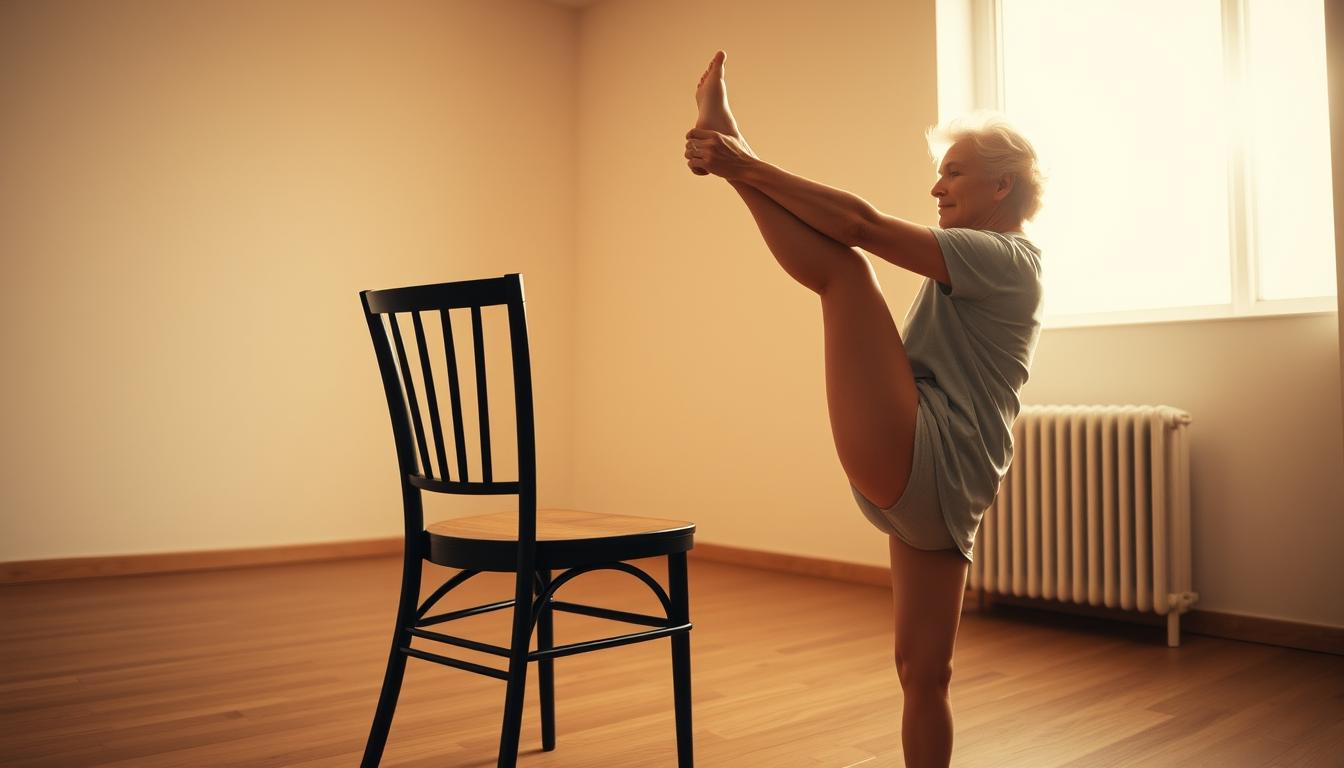Let’s cut to the chase: you don’t need to bench press a truck or sprint like a 20-year-old to stay strong. The Total Gym flips the script on traditional fitness by blending safety with results—even David Jack’s 20-minute program packs punches for your arms, chest, and back without wrecking your joints. Skeptical? I was too… until I saw a 71-year-old neighbor out-lift her grandkids using this setup.
Here’s the kicker: most machines treat aging bodies like broken toys. Not this one. Picture sliding into a recumbent bike warmup that’s gentler than your favorite recliner, then shifting to resistance training that actually respects your spine. No heavy weights. No shaky knees. Just smooth moves that build muscle while dodging injuries—like those golf-friendly rotations that add yards to your swing.
Think 20 minutes is too short? Try 3 sets of 12 reps targeting every major muscle group. You’ll sweat, but you won’t collapse. And if you’ve ever side-eyed gyms as “young people’s clubs,” this routine might just make you a believer. Trust me—your creaky shoulders will thank you later.
Understanding Total Gym Workouts for Seniors

Think gym machines are just for spandex-clad twenty-somethings? I used to believe that too—until I watched a 68-year-old neighbor crush a lat pulldown like it was her morning crossword. Most folks assume these contraptions demand Herculean strength or Olympic-level flexibility. Newsflash: they don’t.
Myth-Busting 101: Machines That Actually Work For You
Here’s the truth bomb: equipment like the seated lateral row isn’t about lifting mountains. It’s about controlled movement that respects creaky joints. Take David Jack’s approach—his 20-minute routine pairs 2 minutes on a recumbent bike with targeted chest press reps. No grunting. No ego lifting. Just smart work that builds golf swing rotations alongside shoulder stability.
Three game-changers I’ve seen:
- Seated row variations that fix slumped postures better than a chiropractor’s reminder
- Lat pulldowns using resistance levels gentler than your grip on the TV remote
- Balance drills disguised as “rest periods” between sets
The Science of Slow & Steady Wins
Forget “no pain, no gain.” Your golden years training should feel like a conversation with your body, not a shouting match. Those 12-rep sets? They’re not about muscle bulk—they’re armor against grocery bag struggles and grandkid pick-up fails. And if anyone claims 20 minutes is too short, show them video demonstrations of 70-year-olds out-working gym bros half their age.
Bottom line: Machines aren’t the enemy. Bad form and unrealistic expectations are. Nail the basics first—your future self will high-five you during gardening season.
Crafting Your Total Gym Routine Safely
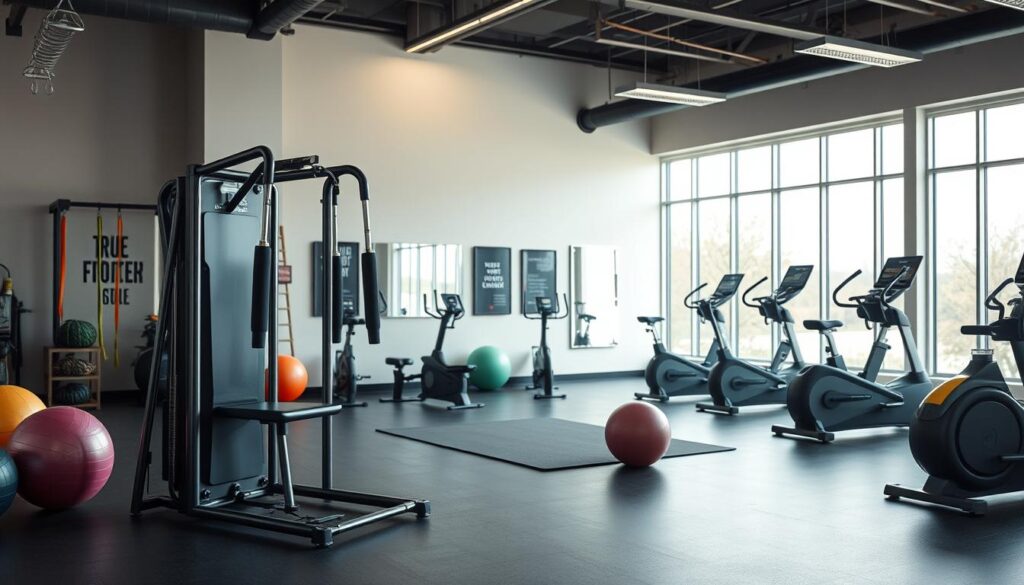
Setting up your workout space shouldn’t feel like solving a Rubik’s cube. I’ve watched too many folks fumble with seat adjustments and grip positions—let’s skip the guesswork. A few tweaks here, a quick check there, and you’ll move like a pro without straining your hips or shoulders.
Setting Up Equipment and Nailing Position Adjustments
Start with the recumbent bike: slide the seat until your knees stay slightly bent at the pedal’s lowest point. Secure your feet snugly—think “cozy slippers,” not “vice grip.” Here’s the kicker: if your legs lock straight, you’re begging for lower back strain. Check the resistance knob—start at level 3, not 10. Your future self will thank you.
Using the Recumbent Bike and Lat Pulldown Effectively
Pedal for 2 minutes to warm up those creaky joints. Keep the pace steady, like a stroll through the park. For the lat pulldown, grab the bar wider than your shoulders—imagine hugging a beach ball. Pull down to collarbone height, not behind your neck. Start light: 15-20 pounds feels better than overdoing it and waking up sore tomorrow.
Focusing on Form with Chest Press and Seated Moves
The chest press isn’t a race. Lie back, plant your feet, and push through your heels—not your toes. Keep your elbows at 45 degrees, like you’re holding a bag of groceries. For seated rows, squeeze your shoulder blades like you’re cracking a walnut. Aim for 12 reps per set, but if your form wobbles, stop. Ego lifting? Not today.
| Exercise | Proper Form | Common Mistakes |
|---|---|---|
| Chest Press | Elbows at 45°, core engaged | Arms flaring out, arching back |
| Seated Row | Shoulders down, slow release | Hunching forward, jerking motion |
| Recumbent Bike | Knees slightly bent, relaxed grip | Overextending legs, death-grip handles |
Trust me: those 20 minutes fly by when you’re not fighting the machine. Stick with 2-3 sets, bump the weight by 5% weekly, and watch how your arms stop protesting during laundry day. Still unsure? Find a video demonstration—sometimes seeing beats reading.
Maximizing Strength and Mobility on the Total Gym
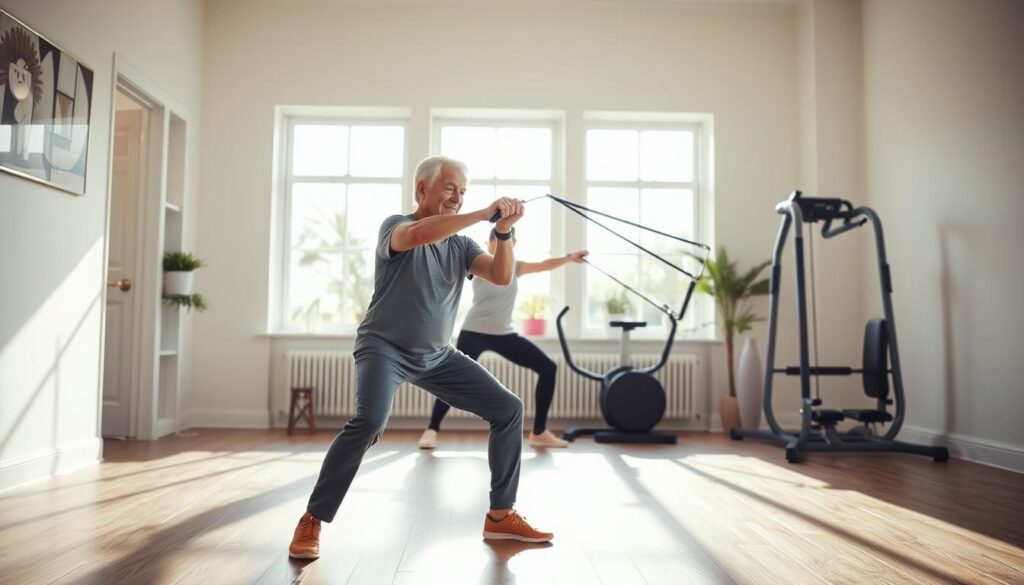
Ever watched a squirrel stash acorns? Smooth, efficient, zero wasted motion. That’s your blueprint here. Forget marathon sessions—this 20-minute mashup of cardio, strength, and flexibility works smarter, not harder. I’ve seen retirees rebuild shoulder mobility just by tweaking their resistance levels and rep counts. Your turn.
Balancing Resistance, Reps, and Dynamic Exercises
Start with 3 sets of 12 reps on the seated row. Keep the weight light enough to maintain control—like steering a shopping cart, not wrestling a grizzly. Dynamic moves? They’re your secret sauce. Mix in lateral presses that mimic reaching for top-shelf spices. Your shoulders get stronger while practicing real-life motions.
Integrating Cardio, Strength, and Flexibility in 20 Minutes
Pedal the recumbent bike for 90 seconds between strength exercises. It’s not about speed—it’s about keeping blood flowing to those working muscles. Finish with a balance drill: single-leg stands while gently pulling the overhead press bar. Feels silly? Maybe. But your hip stabilizers will throw a thank-you party later.
| Component | Reps/Time | Resistance Level |
|---|---|---|
| Seated Row | 12 reps | 30% bodyweight |
| Recumbent Intervals | 90 seconds | Level 4 |
| Overhead Press Holds | 10 sec/side | 20% bodyweight |
Pro tip: Bump your sets by one every two weeks. Track progress in a notebook—or on your fridge with magnets. And if you’re visual? The video demonstration breaks it down better than I can. Remember: It’s not rocket science. Just smart fitness.
Wrapping Up Smart Moves for Lifelong Fitness
Let’s face it: fitness after 60 isn’t about chasing six-packs. It’s about nailing the basics—seat height adjustments, controlled reps, and celebrating small wins. I once watched a neighbor transform her grocery-carrying game just by tweaking her chest press angle. Proof that smart moves beat heavy lifts every time.
Your machine setup matters more than you think. A properly adjusted seat protects your shoulders better than bubble wrap protects china. Keep weights light enough to maintain form—your muscles don’t care about numbers, just consistent challenge.
Twenty minutes? Goldilocks-approved. Short enough to avoid burnout, long enough to spark real change. Pair those seated rows with video demonstrations for instant feedback—like having a coach in your pocket.
Here’s the kicker: age amplifies results from patience, not intensity. Three weekly sessions build armor against stiff joints and weak grips. Saw it firsthand when a 74-year-old client out-lasted me in a gardening marathon after six months of steady work.
Ready for your next move? Adjust one machine setting today. Your future self—lifting grandkids or rearranging furniture—will grin knowing you started here.
